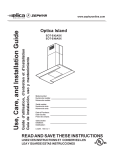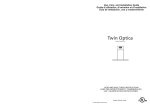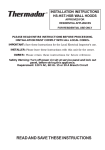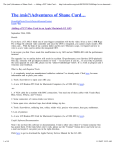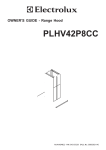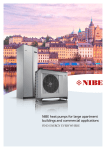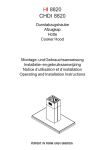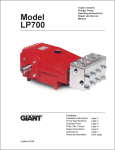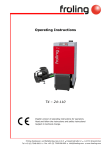Download ELICA Twin Optica Installation guide
Transcript
Use, Care, and Installation Guide Guide dutilisation, dentretien et dinstallation Guía de instalación, uso y mantenimiento Twin Optica Design Team Elica READ AND SAVE THESE INSTRUCTIONS LISEZ CES INSTRUCTIONS ET CONSERVEZ-LES LEA Y GUARDE ESTAS INSTRUCCIONES LI274A ed 05/07 printed in Italy English French Spanish Contents page 2 Sommaire page 14 Contenido página 26 English Contents Important safety Notice ............................................................................................................. 3 Electrical & Installation requirements ...................................................................................... 4 Electrical requirements...............................................................................................................................................................4 Before installing the hood...........................................................................................................................................................4 List of Materials.......................................................................................................................... 5 Parts supplied ............................................................................................................................................................................5 Parts not supplied ......................................................................................................................................................................5 Dimensions and Clearances ..................................................................................................... 5 Ducting Options and Examples ................................................................................................ 6 Venting methods ........................................................................................................................................................................6 Preparation ................................................................................................................................................................................6 Installation .................................................................................................................................. 7 Description of the hood & Controls........................................................................................ 12 Controls....................................................................................................................................................................................12 Maintenance ............................................................................................................................. 12 Cleaning...................................................................................................................................................................................12 Grease Filter ............................................................................................................................................................................12 Replacing the light bulb............................................................................................................................................................13 APPROVED FOR RESIDENTIAL APPLIANCES FOR RESIDENTIAL USE ONLY READ AND SAVE THESE INSTRUCTIONS PLEASE READ ENTIRE INSTRUCTIONS BEFORE PROCEEDING. INSTALLATION MUST COMPLY WITH ALL LOCAL CODES. IMPORTANT: Save these Instructions for the Local Electrical Inspector’s use. INSTALLER: Please leave these Instructions with this unit for the owner. OWNER: Please retain these instructions for future reference. Safety Warning: Turn off power circuit at service panel and lock out panel, before wiring this appliance. Requirement: 120 V AC, 60 Hz. 15 or 20 A Branch Circuit READ AND SAVE THESE INSTRUCTIONS Important safety Notice WARNING CAUTION TO REDUCE THE RISK OF INJURY TO PERSONS, IN THE EVENT OF A RANGE TOP GREASE FIRE, OBSERVE THE FOLLOWING: a) SMOTHER FLAMES with a close-fitting lid, cookie sheet, or other metal tray, then turn off the gas burner or the electric element. BE CAREFUL TO PREVENT BURNS. If the flames do not go out immediately, EVACUATE AND CALL THE FIRE DEPARTMENT. b) NEVER PICK UP A FLAMING PAN - you may be burned. c) DO NOT USE WATER, including wet dishcloths or towels - a violent steam explosion will result. d) Use an extinguisher ONLY if: 1) You know you have a class ABC extinguisher, and you already know how to operate it. 2) The fire is small and contained in the area where it started. 3) The fire department is being called. 4) You can fight the fire with your back to an exit. FOR GENERAL VENTILATING USE ONLY. DO NOT USE TO EXHAUST HAZARDOUS OR EXPLOSIVE MATERIALS OR VAPORS. WARNING TO REDUCE THE RISK OF FIRE, ELECTRIC SHOCK, OR INJURY TO PERSONS, OBSERVE THE FOLLOWING: A. Use this unit only in the manner intended by the manufacturer. If you have questions, contact the manufacturer. B. Before servicing or cleaning the unit, switch power off at service panel and lock service panel disconnecting means to prevent power from being switched on accidentally. When the service disconnecting means cannot be locked, securely fasten a prominent warning device, such as a tag, to the service panel. C. Installation Work and Electrical Wiring Must Be Done By Qualified Person(s) In Accordance With All Applicable Codes & Standards, Including Fire-rated Construction. D. Sufficient air is needed for proper combustion and exhausting of gases through the flue (Chimney) of fuel burning equipment to prevent back- drafting. Follow the heating equipment manufacturers guideline and safety standards such as those published by the National Fire Protection Association (NFPA), the American Society for Heating, Refrigeration and Air Conditioning Engineers (ASHRAE), and the local code authorities. E. When cutting or drilling into wall or ceiling, do not damage electrical wiring and other hidden utilities. F. Ducted systems must always be vented to the outdoors. OPERATION a. Always leave safety grills and filters in place. Without these components, operating blowers could catch onto hair, fingers and loose clothing. The manufacturer declines all responsibility in the event of failure to observe the instructions given here for installation, maintenance and suitable use of the product. The manufacturer further declines all responsibility for injury due to negligence and the warranty of the unit automatically expires due to improper maintenance. * NOTE: Please check our website for revisions before doing any custom work. CAUTION To reduce risk of fire and to properly exhaust air, be sure to duct air outside - do not vent exhaust air into spaces within walls, ceilings, attics, crawl spaces, or garages. WARNING TO REDUCE THE RISK OF FIRE, USE ONLY METAL DUCT WORK. Install this hood in accordance with all requirements specified. WARNING To Reduce The Risk Of Fire Or Electric Shock, Do Not Use This Hood With Any External Solid State Speed Control Device. WARNING TO REDUCE THE RISK OF A RANGE TOP GREASE FIRE. a) Never leave surface units unattended at high settings. Boilovers cause smoking and greasy spillovers that may ignite. Heat oils slowly on low or medium settings. b) Always turn hood ON when cooking at high heat or when flambeing food (I.e. Crepes Suzette, Cherries Jubilee, Peppercorn Beef Flambe’). c) Clean ventilating fans frequently. Grease should not be allowed to accumulate on fan or filter. d) Use proper pan size. Always use cookware appropriate for the size of the surface element. 3 Electrical & Installation requirements Electrical requirements Before installing the hood IMPORTANT 1. For the most efficient air flow exhaust, use a straight run or as few elbows as possible. CAUTION: Vent unit to outside of building, only. Observe all governing codes and ordinances. It is the customer’s responsibility: To contact a qualified electrical installer. To assure that the electrical installation is adequate and in conformance with National Electrical Code, ANSI/NFPA 70 — latest edition*, or CSA Standards C22.1-94, Canadian Electrical Code, Part 1 and C22.2 No.0-M91 - latest edition** and all local codes and ordinances. 2. At least two people are necessary for installation. 3. The hood is fitted with Screws and Drywall Anchors suitable for most surfaces, consult a Qualified Installer, check if they perfectly fit with your cabinet/wall. 4. Do not use flex ducting. If codes permit and a separate ground wire is used, it is recommended that a qualified electrician determine that the ground path is adequate. 5. COLD WEATHER installations should have an additional backdraft damper installed to minimize backward cold air flow and a nonmetallic thermal break to minimize conduction of outside temperatures as part of the ductwork. The damper should be on the cold air side of the thermal break. The break should be as close as possible to where the ducting enters the heated portion of the house. Do not ground to a gas pipe. Check with a qualified electrician if you are not sure range hood is properly grounded. Do not have a fuse in the neutral or ground circuit. IMPORTANT 6. Make up air: Local building codes may require the use of Make-Up Air Systems when using Ducted Ventilation Systems greater than specified CFM of air movement. The specified CFM varies from locale to locale. Consult your HVAC professional for specific requirements in your area. Save Installation Instructions for electrical inspector’s use. The range hood must be connected with copper wire only. The range hood should be connected directly to the fused disconnect (Or circuit breaker) box through metal electrical conduit. Wire sizes must conform to the requirements of the National Electrical Code ANSI/NFPA 70 — latest edition*, or CSA Standards C22.1-94, Canadian Electrical Code Part 1 and C22.2 No. 0-M91 - latest edition** and all local codes and ordinances. A U.L.- or C.S.A.-listed conduit connector must be provided at each end of the power supply conduit (at the range hood and at the junction box). Copies of the standards listed may be obtained from: * National Fire Protection Association Batterymarch Park Quincy, Massachusetts 02269 ** CSA International 8501 East Pleasant Valley Road Cleveland, Ohio 44131-5575 4 List of Materials Parts supplied Parts not supplied • • • • • • • • • Blower unit housing Hood canopy Stainless steel mesh filter Halogen light bulb x 4 Upper and lower Duct covers x 4 Chimney structure Hardware Packet: Allen Wrench Template Use, Care and Installation Guide Warranty Nuts x 12 7x45 screws x 6 4 x 6 screws x 12 (To assemble duct covers) 3,5x6,5 screws x 13 (11 to assemble Hood canopy to Chimney structure + 2 to attach duct covers to chimney structure) 3,5x9,5 screws x 24 (To attach one to another brackets and blower unit) • • • Duct, conduit and all tools required for installation. Ductless Recirculating Kit To be used only in the Ductless (Recirculating) version includes: charcoal filter, charcoal filter support and fixing bracket, deflector Internal blower To be used only in case of Internal blower installation. In-line blower To be used only in case of in-line blower installation Noise reduction sponge Note: may be already included on internal/in-line blower package. CAUTION To reduce the risk of fire and electric shock, install this rangehood only with integral blowers mod. EBI-600 rated 120V 60Hz 450W or with remote blowers mod. EBN-1100 rated 120V 60Hz 900W, manufactured by Elica. Dimensions and Clearances 5 Ducting Options and Examples Closely follow the instructions set out in this manual. All responsibility, for any eventual inconveniences, damages or fires caused by not complying with the instructions in this manual, is declined. Venting methods The hood is equipped with a transition B for discharge of fumes to the outside (Ducting version). Should it not be possible to discharge cooking fumes and vapour to the outside, the hood can be used in the Ductless (Recirculating) version. Attach a charcoal filter and the deflector F on the duct cover support bracket G. Fumes and vapors are recycled through the top grille H by means of a duct connected to the transition B and the transition mounted on the deflector F. NOTE: For ductless (Recirculating) version only: purchase the Ductless Recirculating Kit. Minimum Duct Size (Ducting/Ductless version): 8" Round Pipe. Preparation Do not cut a joist or stud unless absolutely necessary. If a joist or stud must be cut, then a supporting frame must be constructed. Fittings material is provided to secure the hood to most types of walls/ceilings. However, a qualified technician must verify suitability of the materials in accordance with the type of wall/ceiling. Before making cutouts, make sure there is proper clearance within the ceiling or wall for exhaust vent. Hood installation height above cooktop is the users preference. The lower the hood is above the cooktop, the more efficient the capturing of cooking odors, grease and smoke. The hood shall be installed at 24" minimum to 32" above the countertop. Check your ceiling height and the hood height maximum before you select your hood. 6 Installation 1. Pre-installation calculations 2. Preparation of mounting surface K = Kitchen Height Installing supports above ceiling drywall. C = Counter Height (36" standard) P = Prefered Height of Hood Bottom above counter (Recommended 24”-32”) H = Hood height your installation H =K – C – P S = Chimney Structure Height, your installation. S = H - 1" 3/8. a) Select a hood preference height P that is comfortable for the user. (from 24” to 32“). b) Calculate Hood height your installation H = K-C-P. c) Confirm that H is within the range of min to max H found for your model (See “Dimensions and clearances” paragraph). If not adjust your installation. d) Calculate Chimney structure height S. Save this calculation for use later in the installation. Note: Take into consideration the hood depth; the hood could be much deeper than the cooktop. a. Mark center lines of cooktop or range on ceiling above. Use centerlines marked on ceiling to position the mounting template. Note location of hood front (that indicated with a printed arrow), side, and mounting holes indicated on template. Note: Remember that printed arrow on template corresponds to front of the hood and consequently to side where control panels will be located at the end of installation) b. Remove and save template. Cut and remove ceiling drywall. Install suitable length 2" x 4" lumber between joists to provide chimney mounting points as shown above. Use template for dimensions and required clearance. Make sure to affix the added lumber firmly and level. Consult a professional if you have difficulties or your installation is unique. Consult template and Figs.above. c. Install a 8” exhaust duct and extend length = S - 16“ 5/8 from ceiling. Duct shall be securely fastened to joists. Do not use duct smaller than specified. Attention: Duct installation is not required for nonvented (recirculating) installations d. Install 1/2" electrical conduit in location marked on template and extend length = S - 11“ 1/8 from ceiling. Note: If a Remote ventilator installation is 7 required/needed, then provide an additional hole/conduit. e. Install drywall around duct and conduit; then refinish ceiling, leave enough clearance for easy installation of chimney structure up to ceiling (see Installation step 6). WARNING Excessive Weight Hazard Use two or more people to move and install range hood. Failure to do so can result in back or other injury. Make final angular adjustment to structure at ceiling if necessary then securely tighten 4 ceiling lag screws. Fit two additional screws for definitive fixing. f. Tape Template in place and fit 4 screws on mounting holes, do not tighten but leave a space of 1/2“, remove the template. 3. Regulate chimney structure according dimension S (see step 1) and fix all assembly parts with 4 screws to each bracket (32 screws in total - 8 already in place , 24 to be screwed in), check structure is well assembled. 7. Connect ducting to transition. Seal with duct tape. Do not use duct smaller than the transition. For Ductless - recirculating - installations only: provide and install a duct to connect hood transition to deflector (the deflector is available as an extra kit). 4. For non-vented (recirculating) installations ONLY: Fix the deflector on the chimney structure. 5. Note: disregard this step if is intended to install a remote ventilator. Purchase and install the Integral ventilator (see paragraph „Before installing the hood - Parts not supplied“ for model reference). 6. Raise chimney structure up to ceiling (keep 1/2“ conduit and 8“ duct inside the proper passage), use the 4 screws (see step 2/e and 2/f) to hang the hood. Note: Chimeny structure front corresponds to side with electronic box. 8 8. Electrical connection 9. Note: disregard this step if the hood has been fitted with an integralventilator. Purchase and install a Remote ventilator (see paragraph „Before installing the hood - Parts not supplied“ for model reference). WARNING Electrical Shock Hazard Warning: Turn off power circuit at the service panel before wiring this unit. 120 VAC, 15 or 20 Amp circuit required. 10. For non-vented (recirculating) installations ONLY: Install one charcoal filter. ELECTRICAL GROUNDING INSTRUCTIONS THIS APPLIANCE IS FITTED WITH AN ELECTRICAL JUNCTION BOX WITH 3 WIRES, ONE OF WHICH (GREEN/YELLOW) SERVES TO GROUND THE APPLIANCE. TO PROTECT YOU AGAINST ELECTRIC SHOCK, THE GREEN AND YELLOW WIRE MUST BE CONNECTED TO THE GROUNDING WIRE IN YOUR HOME ELECTRICAL SYSTEM, AND IT MUST UNDER NO CIRCUMSTANCES BE CUT OR REMOVED. Failure to do so can result in death or electrical shock. 11. Assemble the canopy with the integral ventilator housing (chimney structure): a. Remove the grease filter (see also Care & Use section - Charcoal filter). b. Thread completely the lower part of the hood onto the integral ventilator housing rails. Note: control panel on canopy and electronic box on chimney structure should be on the same side. c. Make alla cable connections: Facing the front of the range hood, remove the left knockout and the Junction box cover and install the conduit connector (cULus listed) in junction box. Run 3 wires; black, white and green ,according to the National Electrical Code and local codes and ordinances, in 1/2" conduit from service panel to junction box. Connect black wire from service panel to black or red in junction box, white to white and green to green-yellow. Close and secure junction box cover. 9 12. Fix 6 nuts on the internal side of top duct covers sections (squere slots) and fix each other with 6 screws (3 per side). d. Fasten the canopy with 11 screws from the bottom. 13. Install top duct covers assembly to the chimney structure. Fix with 2 screws. Note: Upper Duct Cover may be placed upside down to hide (or unhide) ventless slots. 10 17. Assemble the lower (narrow) trim strips to the lower vent cover assembly. Cut the upper (wide) trim strips to length to fit the upper duct cover assembly. Assemble the upper trim strips to the upper duct cover assembly. 14. Fix 6 nuts on the internal side of rear bottom duct covers section (square slots - see drawings after step 11) and place it on the rear side of the hood on top the canopy, cheack that it snaps with top duct covers assembly. 18. Check all light bulbs to make sure they are secure in their sockets. Turn power on in service panel. Check lights and blower operation per Care & Use section of this manual. If range hood does not operate: 15. Fit the front bottom duct covers section and fix both sections with 8 screws each other (the lower screws fix duct cover to canopy). • • Check that the circuit breaker is not tripped or the house fuse blown. Disconnect power supply. Check that wiring is correct. To get the most efficient use from your new range hood, read the “Use and Care Information” section. Keep your Installation Instructions and Use and Care Guide close to range hood for easy reference. 16. Install filters. 11 Maintenance Description of the hood & Controls ATTENTION! Before performing any maintenance operation, isolate the hood from the electrical supply by switching off at the connector and removing the connector fuse. Or if the appliance has been connected through a plug and socket, then the plug must be removed from the socket. Cleaning The cooker hood should be cleaned regularly (at least with the same frequency with which you carry out maintenance of the fat filters) internally and externally. Clean using the cloth dampened with neutral liquid detergent. Do not use abrasive products. DO NOT USE ALCOHOL! Warning: Failure to carry out the basic cleaning recommendations of the cooker hood and replacement of the filters may cause fire risks. Therefore, we recommend oserving these instructions. The manufacturer declines all responsibility for any damage to the motor or any fire damage linked to inappropriate maintenance or failure to observe the above safety recommendations. 1 2 3 4 5 6 7 Control panel Grease filter Grease filter release handle Halogen lamp (Position and number of lamps may vary) Hood canopy Duct cover Louver holes (Ductless configuration) Grease Filter Traps cooking grease particles. This must be cleaned once a month using non aggressive detergents, either by hand or in the dishwasher, which must be set to a low temperature and a short cycle. When washed in a dishwasher, the grease filter may discolour slightly, but this does not affect its filtering capacity. To remove the grease filter, pull the spring release handle. Controls Use the high suction speed in cases of concentrated kitchen vapours. It is recommended that the cooker hood suction is switched on for 5 minutes prior to cooking and to leave in operation during cooking and for another 15 minutes approximately after terminating cooking. Note: Hood retains last speed setting when aspiration switch is turned off. Description of control panel A. on/off light switch B. on/off aspiration switch and minimum power selection B+C. medium power selection aspiration switch B+D. maximum power selection aspiration switch 12 Replacing the light bulb Disconnect the hood from the electricity. Warning! Prior to touching the light bulbs ensure they are cooled down. 1. Using a flat head screwdriver or equivalent tool, carefully pry loose the light cover. 2. Remove the damaged light and replace with a new 12 Volt, 20 Watt (Maximum) halogen light made for a G-4 base SUITABLE FOR USE IN OPEN LUMINAIRES. Follow package directions and do not touch new light with bare hands. 3. Reinstall the light cover. (it will snap shut). If the lights do not work, make sure that the lamps are fitted properly into their housings before you call for technical assistance. 13













